Duties of Nurse Educator in Ensuring Cultural Accommodation
VerifiedAdded on 2021/04/21
|13
|3238
|39
AI Summary
This assignment delves into the role of a nurse educator in accommodating cultural differences in the classroom. The educator's responsibilities include teaching students to respect other cultures, promote cultural diversity, awareness, sensitivity, and safety. This enables effective communication and harmonious living among students from diverse backgrounds.
Contribute Materials
Your contribution can guide someone’s learning journey. Share your
documents today.
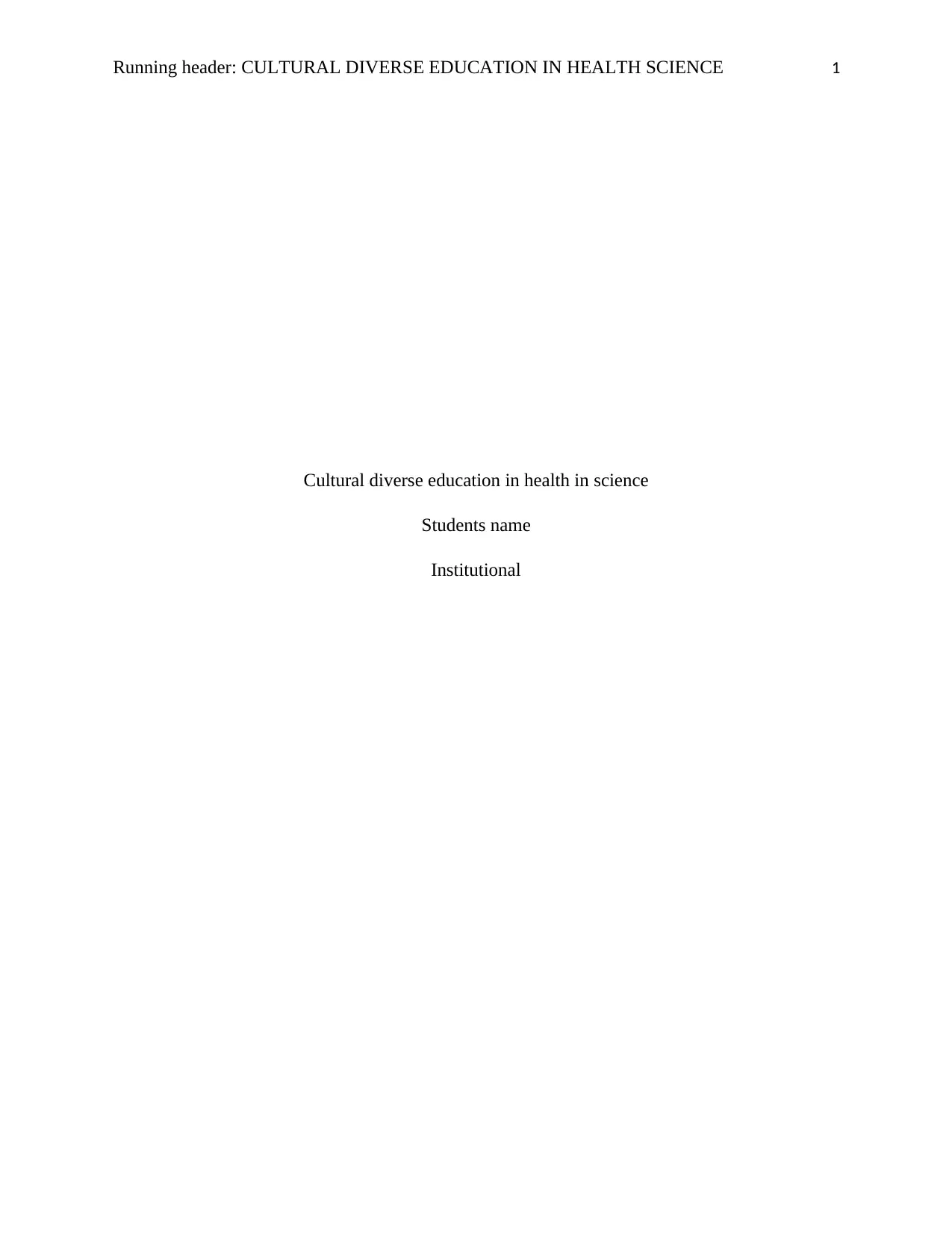
Running header: CULTURAL DIVERSE EDUCATION IN HEALTH SCIENCE 1
Cultural diverse education in health in science
Students name
Institutional
Cultural diverse education in health in science
Students name
Institutional
Secure Best Marks with AI Grader
Need help grading? Try our AI Grader for instant feedback on your assignments.
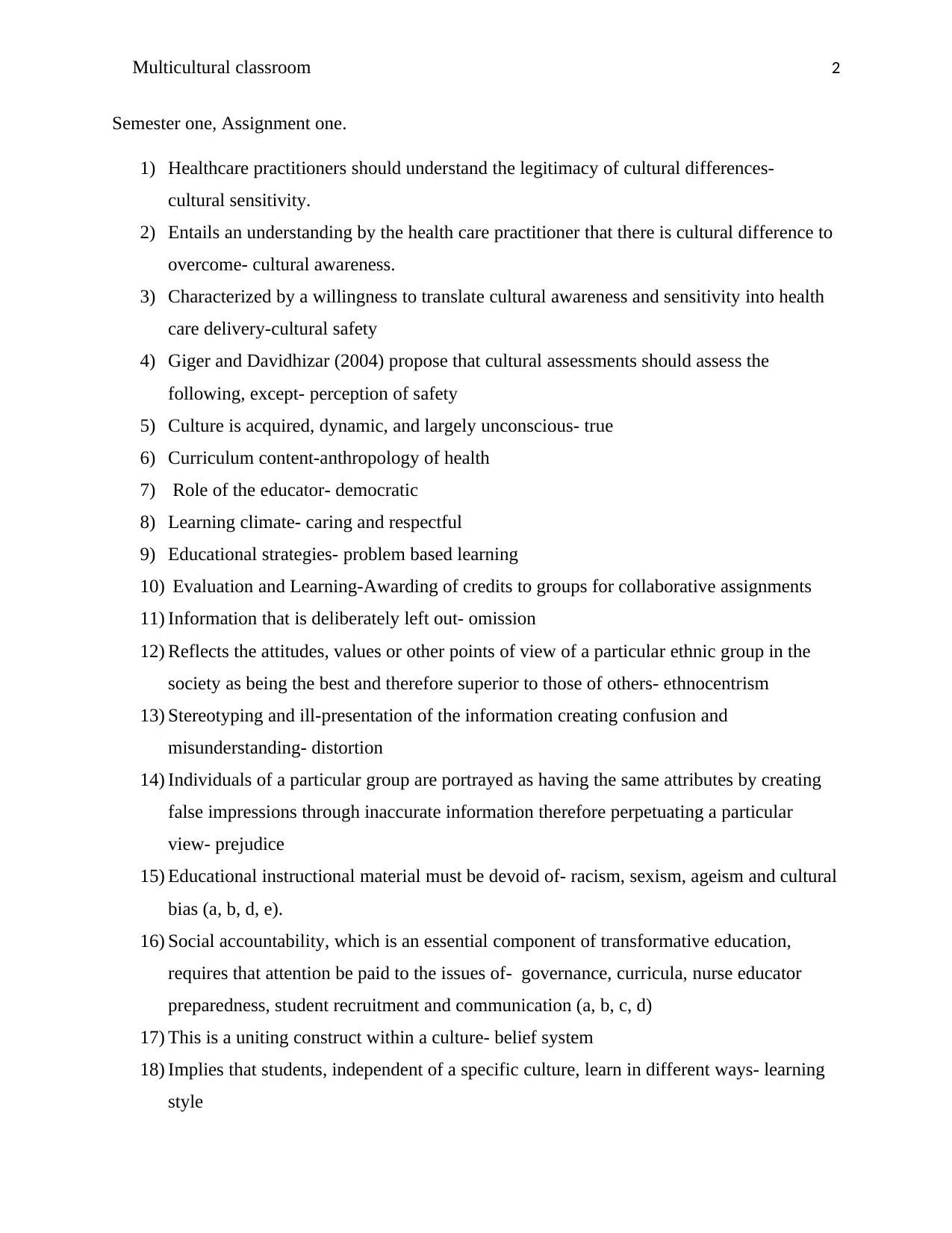
Multicultural classroom 2
Semester one, Assignment one.
1) Healthcare practitioners should understand the legitimacy of cultural differences-
cultural sensitivity.
2) Entails an understanding by the health care practitioner that there is cultural difference to
overcome- cultural awareness.
3) Characterized by a willingness to translate cultural awareness and sensitivity into health
care delivery-cultural safety
4) Giger and Davidhizar (2004) propose that cultural assessments should assess the
following, except- perception of safety
5) Culture is acquired, dynamic, and largely unconscious- true
6) Curriculum content-anthropology of health
7) Role of the educator- democratic
8) Learning climate- caring and respectful
9) Educational strategies- problem based learning
10) Evaluation and Learning-Awarding of credits to groups for collaborative assignments
11) Information that is deliberately left out- omission
12) Reflects the attitudes, values or other points of view of a particular ethnic group in the
society as being the best and therefore superior to those of others- ethnocentrism
13) Stereotyping and ill-presentation of the information creating confusion and
misunderstanding- distortion
14) Individuals of a particular group are portrayed as having the same attributes by creating
false impressions through inaccurate information therefore perpetuating a particular
view- prejudice
15) Educational instructional material must be devoid of- racism, sexism, ageism and cultural
bias (a, b, d, e).
16) Social accountability, which is an essential component of transformative education,
requires that attention be paid to the issues of- governance, curricula, nurse educator
preparedness, student recruitment and communication (a, b, c, d)
17) This is a uniting construct within a culture- belief system
18) Implies that students, independent of a specific culture, learn in different ways- learning
style
Semester one, Assignment one.
1) Healthcare practitioners should understand the legitimacy of cultural differences-
cultural sensitivity.
2) Entails an understanding by the health care practitioner that there is cultural difference to
overcome- cultural awareness.
3) Characterized by a willingness to translate cultural awareness and sensitivity into health
care delivery-cultural safety
4) Giger and Davidhizar (2004) propose that cultural assessments should assess the
following, except- perception of safety
5) Culture is acquired, dynamic, and largely unconscious- true
6) Curriculum content-anthropology of health
7) Role of the educator- democratic
8) Learning climate- caring and respectful
9) Educational strategies- problem based learning
10) Evaluation and Learning-Awarding of credits to groups for collaborative assignments
11) Information that is deliberately left out- omission
12) Reflects the attitudes, values or other points of view of a particular ethnic group in the
society as being the best and therefore superior to those of others- ethnocentrism
13) Stereotyping and ill-presentation of the information creating confusion and
misunderstanding- distortion
14) Individuals of a particular group are portrayed as having the same attributes by creating
false impressions through inaccurate information therefore perpetuating a particular
view- prejudice
15) Educational instructional material must be devoid of- racism, sexism, ageism and cultural
bias (a, b, d, e).
16) Social accountability, which is an essential component of transformative education,
requires that attention be paid to the issues of- governance, curricula, nurse educator
preparedness, student recruitment and communication (a, b, c, d)
17) This is a uniting construct within a culture- belief system
18) Implies that students, independent of a specific culture, learn in different ways- learning
style
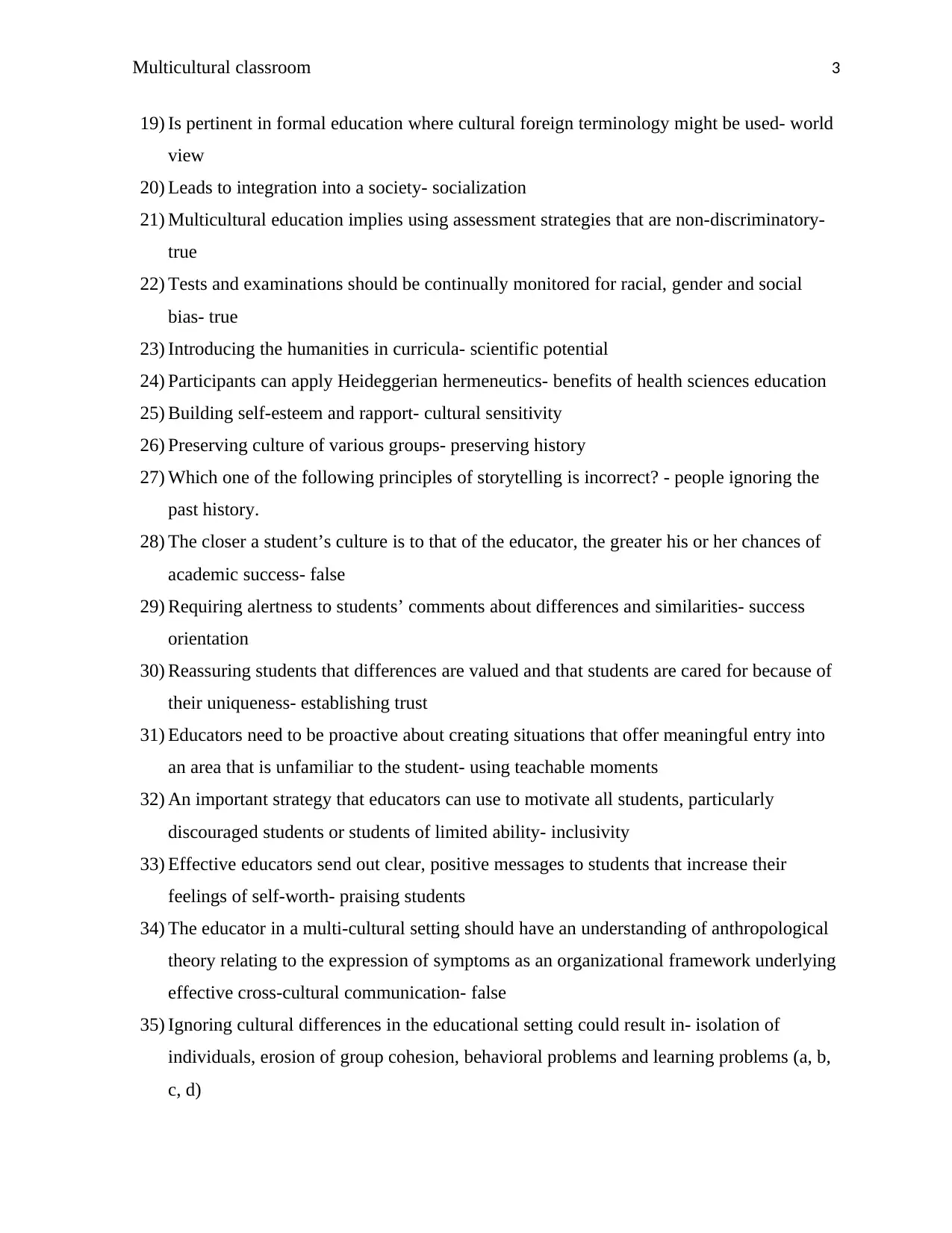
Multicultural classroom 3
19) Is pertinent in formal education where cultural foreign terminology might be used- world
view
20) Leads to integration into a society- socialization
21) Multicultural education implies using assessment strategies that are non-discriminatory-
true
22) Tests and examinations should be continually monitored for racial, gender and social
bias- true
23) Introducing the humanities in curricula- scientific potential
24) Participants can apply Heideggerian hermeneutics- benefits of health sciences education
25) Building self-esteem and rapport- cultural sensitivity
26) Preserving culture of various groups- preserving history
27) Which one of the following principles of storytelling is incorrect? - people ignoring the
past history.
28) The closer a student’s culture is to that of the educator, the greater his or her chances of
academic success- false
29) Requiring alertness to students’ comments about differences and similarities- success
orientation
30) Reassuring students that differences are valued and that students are cared for because of
their uniqueness- establishing trust
31) Educators need to be proactive about creating situations that offer meaningful entry into
an area that is unfamiliar to the student- using teachable moments
32) An important strategy that educators can use to motivate all students, particularly
discouraged students or students of limited ability- inclusivity
33) Effective educators send out clear, positive messages to students that increase their
feelings of self-worth- praising students
34) The educator in a multi-cultural setting should have an understanding of anthropological
theory relating to the expression of symptoms as an organizational framework underlying
effective cross-cultural communication- false
35) Ignoring cultural differences in the educational setting could result in- isolation of
individuals, erosion of group cohesion, behavioral problems and learning problems (a, b,
c, d)
19) Is pertinent in formal education where cultural foreign terminology might be used- world
view
20) Leads to integration into a society- socialization
21) Multicultural education implies using assessment strategies that are non-discriminatory-
true
22) Tests and examinations should be continually monitored for racial, gender and social
bias- true
23) Introducing the humanities in curricula- scientific potential
24) Participants can apply Heideggerian hermeneutics- benefits of health sciences education
25) Building self-esteem and rapport- cultural sensitivity
26) Preserving culture of various groups- preserving history
27) Which one of the following principles of storytelling is incorrect? - people ignoring the
past history.
28) The closer a student’s culture is to that of the educator, the greater his or her chances of
academic success- false
29) Requiring alertness to students’ comments about differences and similarities- success
orientation
30) Reassuring students that differences are valued and that students are cared for because of
their uniqueness- establishing trust
31) Educators need to be proactive about creating situations that offer meaningful entry into
an area that is unfamiliar to the student- using teachable moments
32) An important strategy that educators can use to motivate all students, particularly
discouraged students or students of limited ability- inclusivity
33) Effective educators send out clear, positive messages to students that increase their
feelings of self-worth- praising students
34) The educator in a multi-cultural setting should have an understanding of anthropological
theory relating to the expression of symptoms as an organizational framework underlying
effective cross-cultural communication- false
35) Ignoring cultural differences in the educational setting could result in- isolation of
individuals, erosion of group cohesion, behavioral problems and learning problems (a, b,
c, d)
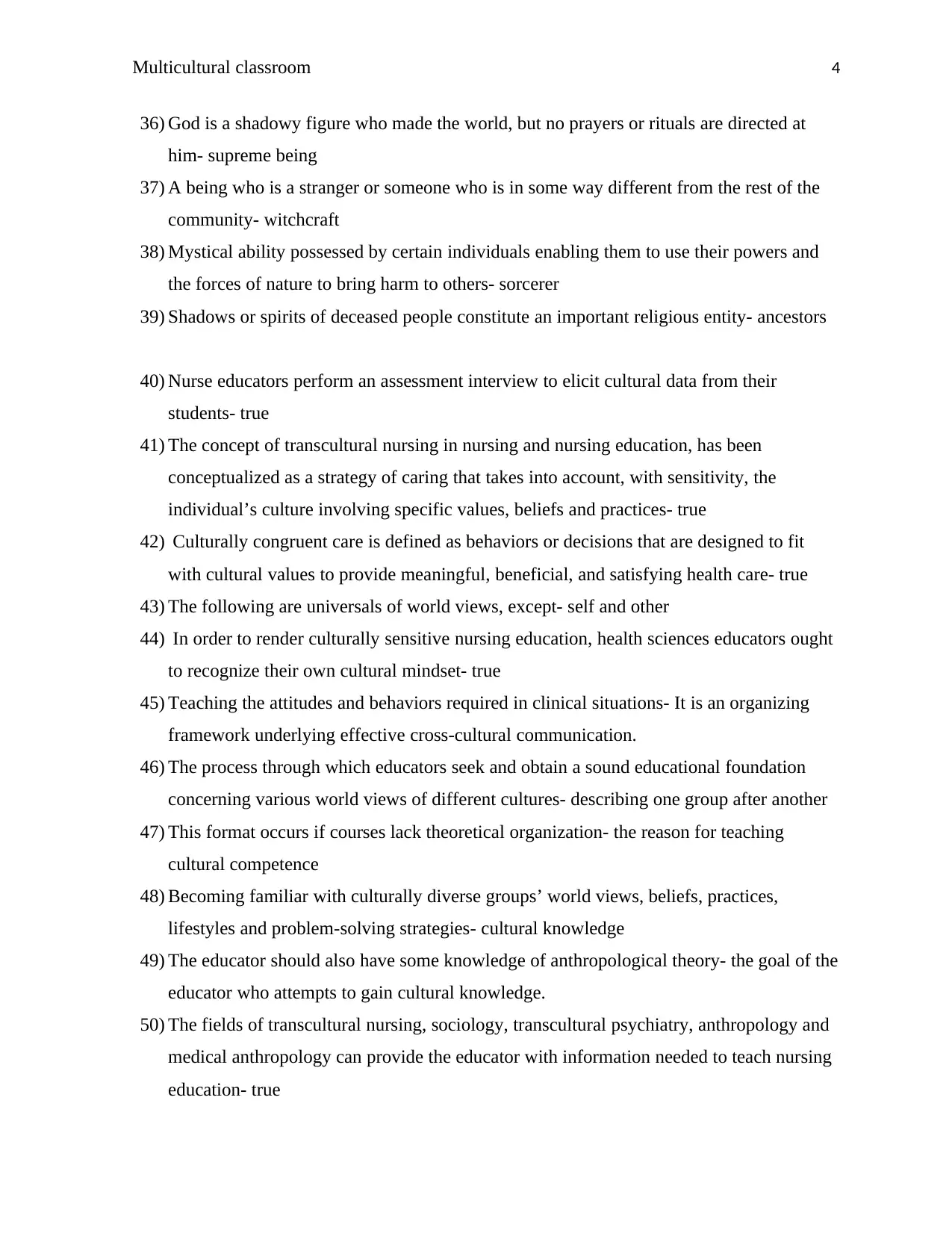
Multicultural classroom 4
36) God is a shadowy figure who made the world, but no prayers or rituals are directed at
him- supreme being
37) A being who is a stranger or someone who is in some way different from the rest of the
community- witchcraft
38) Mystical ability possessed by certain individuals enabling them to use their powers and
the forces of nature to bring harm to others- sorcerer
39) Shadows or spirits of deceased people constitute an important religious entity- ancestors
40) Nurse educators perform an assessment interview to elicit cultural data from their
students- true
41) The concept of transcultural nursing in nursing and nursing education, has been
conceptualized as a strategy of caring that takes into account, with sensitivity, the
individual’s culture involving specific values, beliefs and practices- true
42) Culturally congruent care is defined as behaviors or decisions that are designed to fit
with cultural values to provide meaningful, beneficial, and satisfying health care- true
43) The following are universals of world views, except- self and other
44) In order to render culturally sensitive nursing education, health sciences educators ought
to recognize their own cultural mindset- true
45) Teaching the attitudes and behaviors required in clinical situations- It is an organizing
framework underlying effective cross-cultural communication.
46) The process through which educators seek and obtain a sound educational foundation
concerning various world views of different cultures- describing one group after another
47) This format occurs if courses lack theoretical organization- the reason for teaching
cultural competence
48) Becoming familiar with culturally diverse groups’ world views, beliefs, practices,
lifestyles and problem-solving strategies- cultural knowledge
49) The educator should also have some knowledge of anthropological theory- the goal of the
educator who attempts to gain cultural knowledge.
50) The fields of transcultural nursing, sociology, transcultural psychiatry, anthropology and
medical anthropology can provide the educator with information needed to teach nursing
education- true
36) God is a shadowy figure who made the world, but no prayers or rituals are directed at
him- supreme being
37) A being who is a stranger or someone who is in some way different from the rest of the
community- witchcraft
38) Mystical ability possessed by certain individuals enabling them to use their powers and
the forces of nature to bring harm to others- sorcerer
39) Shadows or spirits of deceased people constitute an important religious entity- ancestors
40) Nurse educators perform an assessment interview to elicit cultural data from their
students- true
41) The concept of transcultural nursing in nursing and nursing education, has been
conceptualized as a strategy of caring that takes into account, with sensitivity, the
individual’s culture involving specific values, beliefs and practices- true
42) Culturally congruent care is defined as behaviors or decisions that are designed to fit
with cultural values to provide meaningful, beneficial, and satisfying health care- true
43) The following are universals of world views, except- self and other
44) In order to render culturally sensitive nursing education, health sciences educators ought
to recognize their own cultural mindset- true
45) Teaching the attitudes and behaviors required in clinical situations- It is an organizing
framework underlying effective cross-cultural communication.
46) The process through which educators seek and obtain a sound educational foundation
concerning various world views of different cultures- describing one group after another
47) This format occurs if courses lack theoretical organization- the reason for teaching
cultural competence
48) Becoming familiar with culturally diverse groups’ world views, beliefs, practices,
lifestyles and problem-solving strategies- cultural knowledge
49) The educator should also have some knowledge of anthropological theory- the goal of the
educator who attempts to gain cultural knowledge.
50) The fields of transcultural nursing, sociology, transcultural psychiatry, anthropology and
medical anthropology can provide the educator with information needed to teach nursing
education- true
Secure Best Marks with AI Grader
Need help grading? Try our AI Grader for instant feedback on your assignments.
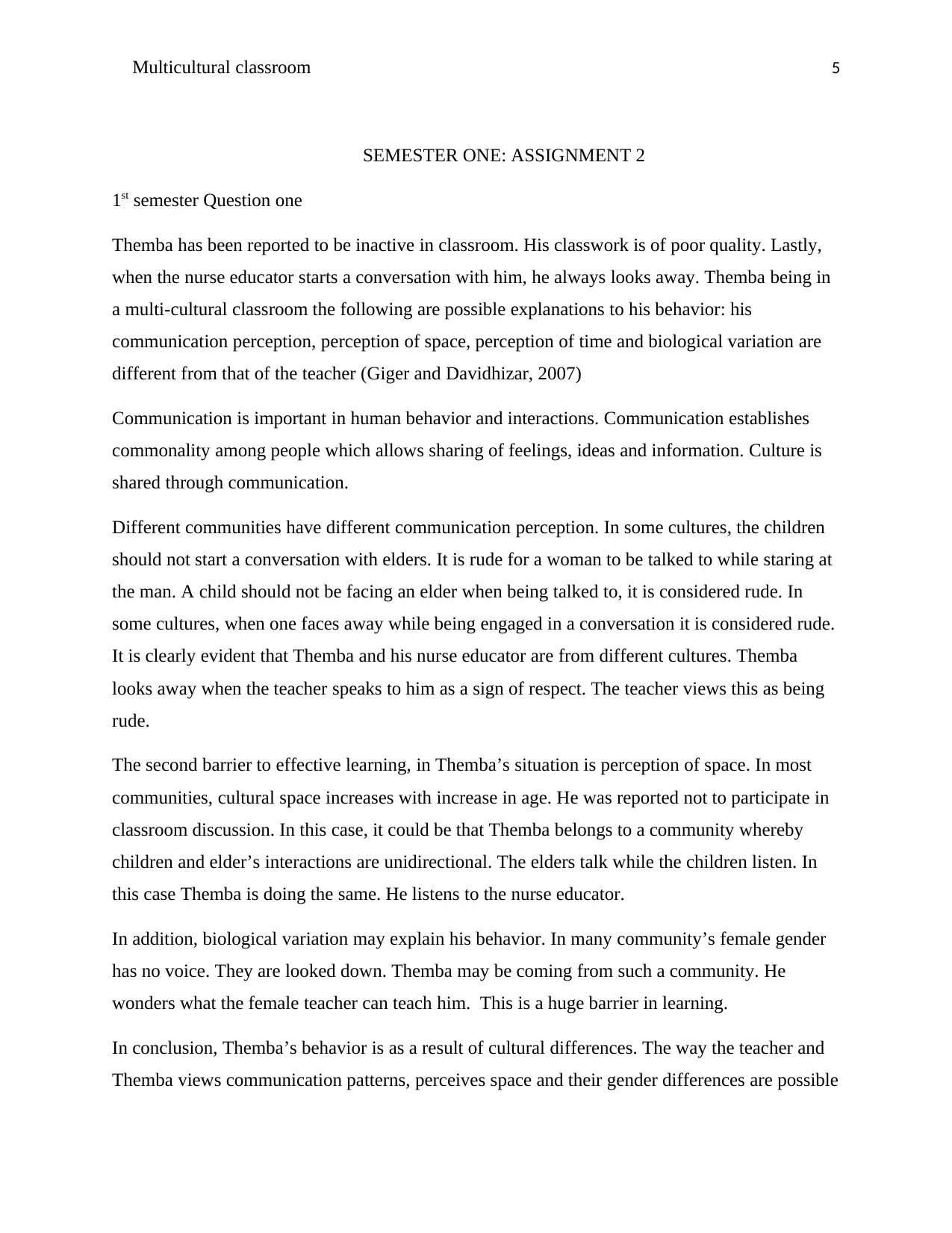
Multicultural classroom 5
SEMESTER ONE: ASSIGNMENT 2
1st semester Question one
Themba has been reported to be inactive in classroom. His classwork is of poor quality. Lastly,
when the nurse educator starts a conversation with him, he always looks away. Themba being in
a multi-cultural classroom the following are possible explanations to his behavior: his
communication perception, perception of space, perception of time and biological variation are
different from that of the teacher (Giger and Davidhizar, 2007)
Communication is important in human behavior and interactions. Communication establishes
commonality among people which allows sharing of feelings, ideas and information. Culture is
shared through communication.
Different communities have different communication perception. In some cultures, the children
should not start a conversation with elders. It is rude for a woman to be talked to while staring at
the man. A child should not be facing an elder when being talked to, it is considered rude. In
some cultures, when one faces away while being engaged in a conversation it is considered rude.
It is clearly evident that Themba and his nurse educator are from different cultures. Themba
looks away when the teacher speaks to him as a sign of respect. The teacher views this as being
rude.
The second barrier to effective learning, in Themba’s situation is perception of space. In most
communities, cultural space increases with increase in age. He was reported not to participate in
classroom discussion. In this case, it could be that Themba belongs to a community whereby
children and elder’s interactions are unidirectional. The elders talk while the children listen. In
this case Themba is doing the same. He listens to the nurse educator.
In addition, biological variation may explain his behavior. In many community’s female gender
has no voice. They are looked down. Themba may be coming from such a community. He
wonders what the female teacher can teach him. This is a huge barrier in learning.
In conclusion, Themba’s behavior is as a result of cultural differences. The way the teacher and
Themba views communication patterns, perceives space and their gender differences are possible
SEMESTER ONE: ASSIGNMENT 2
1st semester Question one
Themba has been reported to be inactive in classroom. His classwork is of poor quality. Lastly,
when the nurse educator starts a conversation with him, he always looks away. Themba being in
a multi-cultural classroom the following are possible explanations to his behavior: his
communication perception, perception of space, perception of time and biological variation are
different from that of the teacher (Giger and Davidhizar, 2007)
Communication is important in human behavior and interactions. Communication establishes
commonality among people which allows sharing of feelings, ideas and information. Culture is
shared through communication.
Different communities have different communication perception. In some cultures, the children
should not start a conversation with elders. It is rude for a woman to be talked to while staring at
the man. A child should not be facing an elder when being talked to, it is considered rude. In
some cultures, when one faces away while being engaged in a conversation it is considered rude.
It is clearly evident that Themba and his nurse educator are from different cultures. Themba
looks away when the teacher speaks to him as a sign of respect. The teacher views this as being
rude.
The second barrier to effective learning, in Themba’s situation is perception of space. In most
communities, cultural space increases with increase in age. He was reported not to participate in
classroom discussion. In this case, it could be that Themba belongs to a community whereby
children and elder’s interactions are unidirectional. The elders talk while the children listen. In
this case Themba is doing the same. He listens to the nurse educator.
In addition, biological variation may explain his behavior. In many community’s female gender
has no voice. They are looked down. Themba may be coming from such a community. He
wonders what the female teacher can teach him. This is a huge barrier in learning.
In conclusion, Themba’s behavior is as a result of cultural differences. The way the teacher and
Themba views communication patterns, perceives space and their gender differences are possible
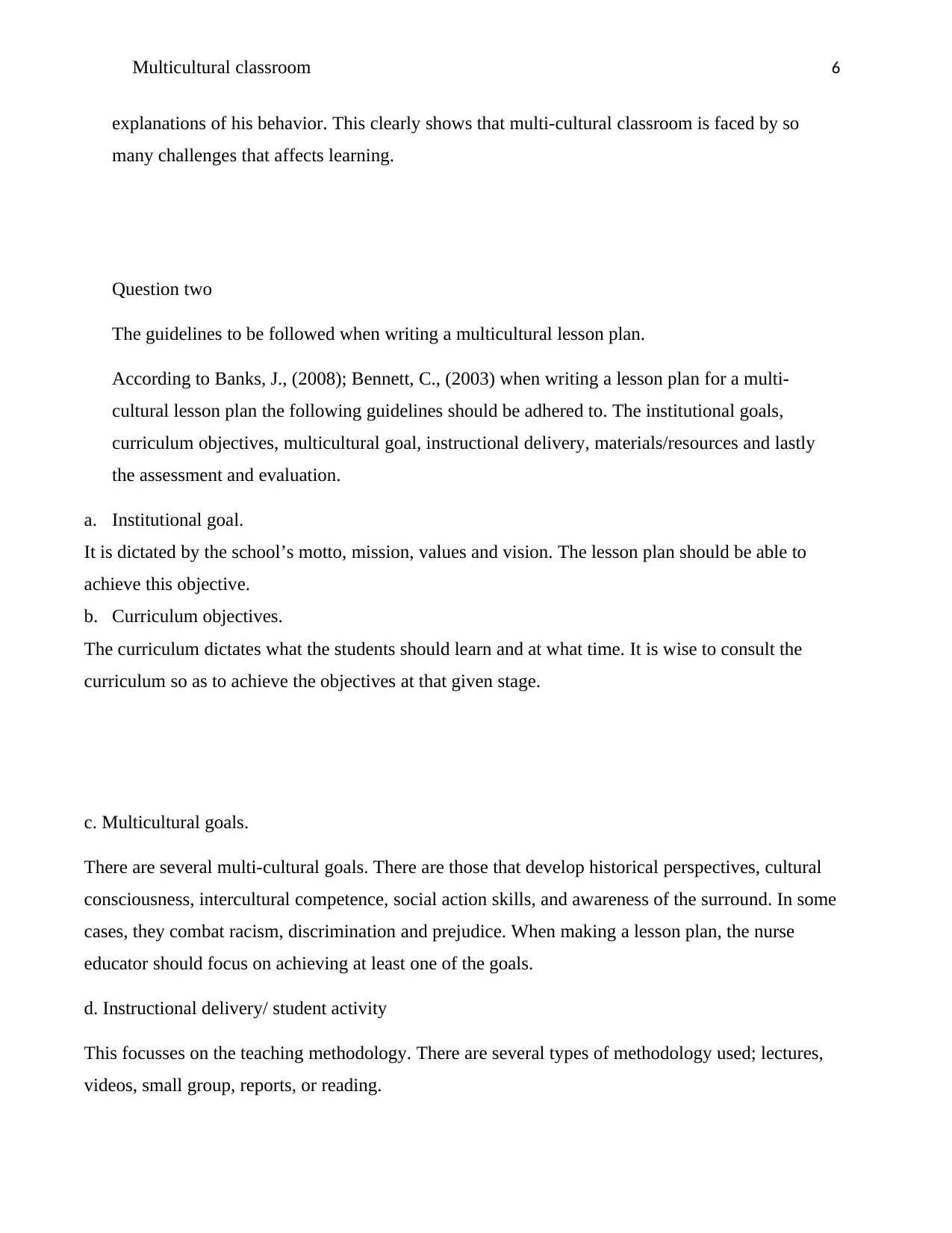
Multicultural classroom 6
explanations of his behavior. This clearly shows that multi-cultural classroom is faced by so
many challenges that affects learning.
Question two
The guidelines to be followed when writing a multicultural lesson plan.
According to Banks, J., (2008); Bennett, C., (2003) when writing a lesson plan for a multi-
cultural lesson plan the following guidelines should be adhered to. The institutional goals,
curriculum objectives, multicultural goal, instructional delivery, materials/resources and lastly
the assessment and evaluation.
a. Institutional goal.
It is dictated by the school’s motto, mission, values and vision. The lesson plan should be able to
achieve this objective.
b. Curriculum objectives.
The curriculum dictates what the students should learn and at what time. It is wise to consult the
curriculum so as to achieve the objectives at that given stage.
c. Multicultural goals.
There are several multi-cultural goals. There are those that develop historical perspectives, cultural
consciousness, intercultural competence, social action skills, and awareness of the surround. In some
cases, they combat racism, discrimination and prejudice. When making a lesson plan, the nurse
educator should focus on achieving at least one of the goals.
d. Instructional delivery/ student activity
This focusses on the teaching methodology. There are several types of methodology used; lectures,
videos, small group, reports, or reading.
explanations of his behavior. This clearly shows that multi-cultural classroom is faced by so
many challenges that affects learning.
Question two
The guidelines to be followed when writing a multicultural lesson plan.
According to Banks, J., (2008); Bennett, C., (2003) when writing a lesson plan for a multi-
cultural lesson plan the following guidelines should be adhered to. The institutional goals,
curriculum objectives, multicultural goal, instructional delivery, materials/resources and lastly
the assessment and evaluation.
a. Institutional goal.
It is dictated by the school’s motto, mission, values and vision. The lesson plan should be able to
achieve this objective.
b. Curriculum objectives.
The curriculum dictates what the students should learn and at what time. It is wise to consult the
curriculum so as to achieve the objectives at that given stage.
c. Multicultural goals.
There are several multi-cultural goals. There are those that develop historical perspectives, cultural
consciousness, intercultural competence, social action skills, and awareness of the surround. In some
cases, they combat racism, discrimination and prejudice. When making a lesson plan, the nurse
educator should focus on achieving at least one of the goals.
d. Instructional delivery/ student activity
This focusses on the teaching methodology. There are several types of methodology used; lectures,
videos, small group, reports, or reading.
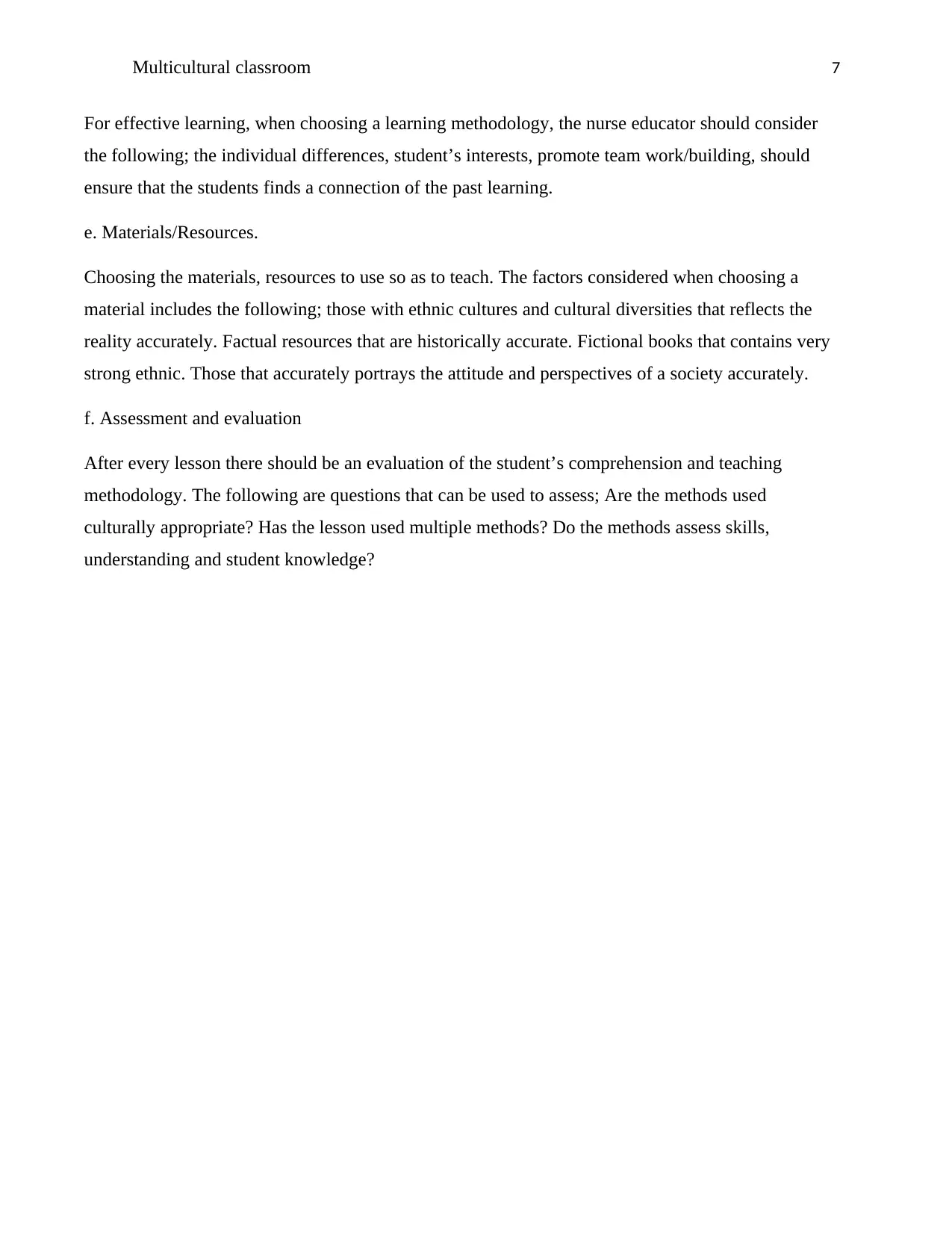
Multicultural classroom 7
For effective learning, when choosing a learning methodology, the nurse educator should consider
the following; the individual differences, student’s interests, promote team work/building, should
ensure that the students finds a connection of the past learning.
e. Materials/Resources.
Choosing the materials, resources to use so as to teach. The factors considered when choosing a
material includes the following; those with ethnic cultures and cultural diversities that reflects the
reality accurately. Factual resources that are historically accurate. Fictional books that contains very
strong ethnic. Those that accurately portrays the attitude and perspectives of a society accurately.
f. Assessment and evaluation
After every lesson there should be an evaluation of the student’s comprehension and teaching
methodology. The following are questions that can be used to assess; Are the methods used
culturally appropriate? Has the lesson used multiple methods? Do the methods assess skills,
understanding and student knowledge?
For effective learning, when choosing a learning methodology, the nurse educator should consider
the following; the individual differences, student’s interests, promote team work/building, should
ensure that the students finds a connection of the past learning.
e. Materials/Resources.
Choosing the materials, resources to use so as to teach. The factors considered when choosing a
material includes the following; those with ethnic cultures and cultural diversities that reflects the
reality accurately. Factual resources that are historically accurate. Fictional books that contains very
strong ethnic. Those that accurately portrays the attitude and perspectives of a society accurately.
f. Assessment and evaluation
After every lesson there should be an evaluation of the student’s comprehension and teaching
methodology. The following are questions that can be used to assess; Are the methods used
culturally appropriate? Has the lesson used multiple methods? Do the methods assess skills,
understanding and student knowledge?
Paraphrase This Document
Need a fresh take? Get an instant paraphrase of this document with our AI Paraphraser
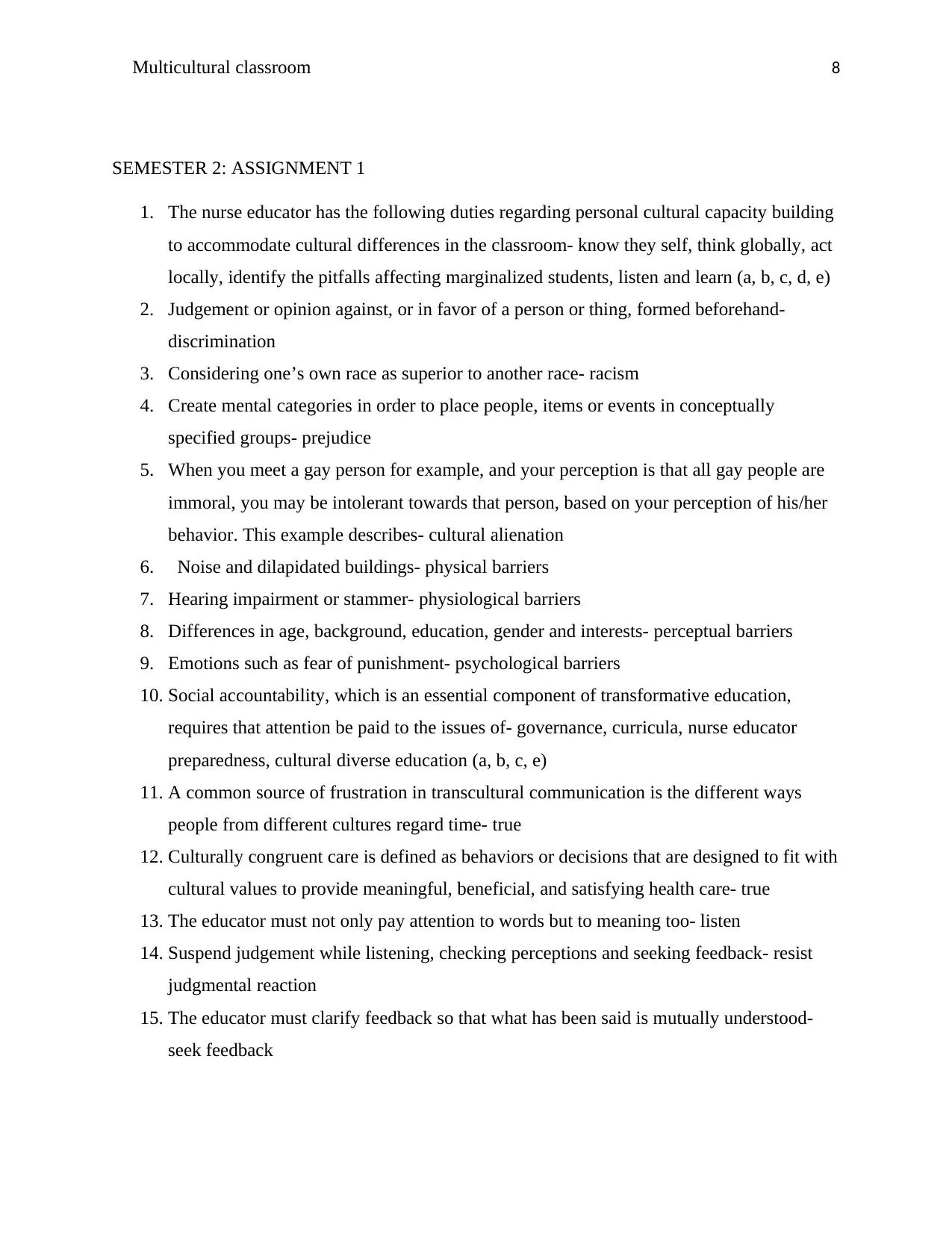
Multicultural classroom 8
SEMESTER 2: ASSIGNMENT 1
1. The nurse educator has the following duties regarding personal cultural capacity building
to accommodate cultural differences in the classroom- know they self, think globally, act
locally, identify the pitfalls affecting marginalized students, listen and learn (a, b, c, d, e)
2. Judgement or opinion against, or in favor of a person or thing, formed beforehand-
discrimination
3. Considering one’s own race as superior to another race- racism
4. Create mental categories in order to place people, items or events in conceptually
specified groups- prejudice
5. When you meet a gay person for example, and your perception is that all gay people are
immoral, you may be intolerant towards that person, based on your perception of his/her
behavior. This example describes- cultural alienation
6. Noise and dilapidated buildings- physical barriers
7. Hearing impairment or stammer- physiological barriers
8. Differences in age, background, education, gender and interests- perceptual barriers
9. Emotions such as fear of punishment- psychological barriers
10. Social accountability, which is an essential component of transformative education,
requires that attention be paid to the issues of- governance, curricula, nurse educator
preparedness, cultural diverse education (a, b, c, e)
11. A common source of frustration in transcultural communication is the different ways
people from different cultures regard time- true
12. Culturally congruent care is defined as behaviors or decisions that are designed to fit with
cultural values to provide meaningful, beneficial, and satisfying health care- true
13. The educator must not only pay attention to words but to meaning too- listen
14. Suspend judgement while listening, checking perceptions and seeking feedback- resist
judgmental reaction
15. The educator must clarify feedback so that what has been said is mutually understood-
seek feedback
SEMESTER 2: ASSIGNMENT 1
1. The nurse educator has the following duties regarding personal cultural capacity building
to accommodate cultural differences in the classroom- know they self, think globally, act
locally, identify the pitfalls affecting marginalized students, listen and learn (a, b, c, d, e)
2. Judgement or opinion against, or in favor of a person or thing, formed beforehand-
discrimination
3. Considering one’s own race as superior to another race- racism
4. Create mental categories in order to place people, items or events in conceptually
specified groups- prejudice
5. When you meet a gay person for example, and your perception is that all gay people are
immoral, you may be intolerant towards that person, based on your perception of his/her
behavior. This example describes- cultural alienation
6. Noise and dilapidated buildings- physical barriers
7. Hearing impairment or stammer- physiological barriers
8. Differences in age, background, education, gender and interests- perceptual barriers
9. Emotions such as fear of punishment- psychological barriers
10. Social accountability, which is an essential component of transformative education,
requires that attention be paid to the issues of- governance, curricula, nurse educator
preparedness, cultural diverse education (a, b, c, e)
11. A common source of frustration in transcultural communication is the different ways
people from different cultures regard time- true
12. Culturally congruent care is defined as behaviors or decisions that are designed to fit with
cultural values to provide meaningful, beneficial, and satisfying health care- true
13. The educator must not only pay attention to words but to meaning too- listen
14. Suspend judgement while listening, checking perceptions and seeking feedback- resist
judgmental reaction
15. The educator must clarify feedback so that what has been said is mutually understood-
seek feedback
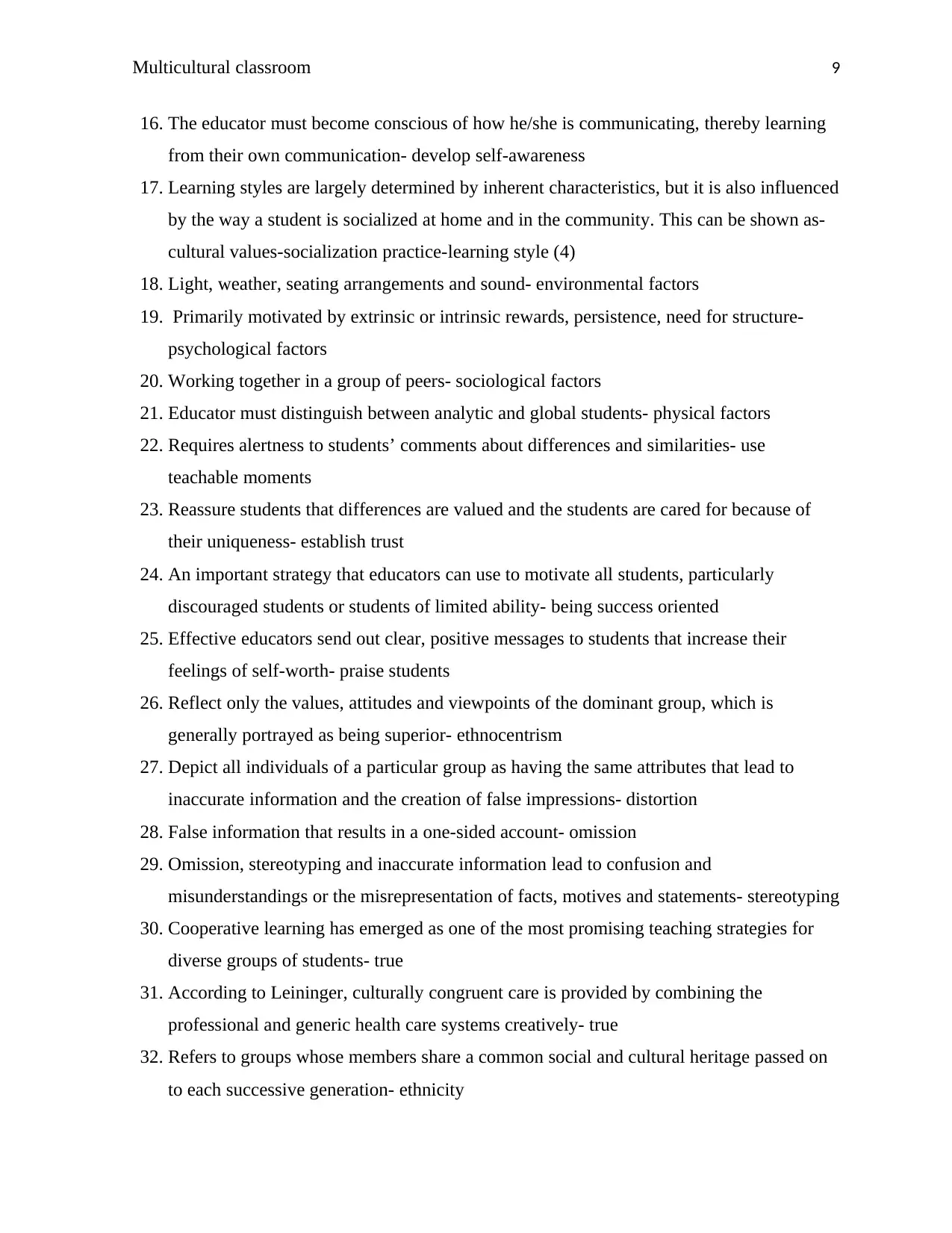
Multicultural classroom 9
16. The educator must become conscious of how he/she is communicating, thereby learning
from their own communication- develop self-awareness
17. Learning styles are largely determined by inherent characteristics, but it is also influenced
by the way a student is socialized at home and in the community. This can be shown as-
cultural values-socialization practice-learning style (4)
18. Light, weather, seating arrangements and sound- environmental factors
19. Primarily motivated by extrinsic or intrinsic rewards, persistence, need for structure-
psychological factors
20. Working together in a group of peers- sociological factors
21. Educator must distinguish between analytic and global students- physical factors
22. Requires alertness to students’ comments about differences and similarities- use
teachable moments
23. Reassure students that differences are valued and the students are cared for because of
their uniqueness- establish trust
24. An important strategy that educators can use to motivate all students, particularly
discouraged students or students of limited ability- being success oriented
25. Effective educators send out clear, positive messages to students that increase their
feelings of self-worth- praise students
26. Reflect only the values, attitudes and viewpoints of the dominant group, which is
generally portrayed as being superior- ethnocentrism
27. Depict all individuals of a particular group as having the same attributes that lead to
inaccurate information and the creation of false impressions- distortion
28. False information that results in a one-sided account- omission
29. Omission, stereotyping and inaccurate information lead to confusion and
misunderstandings or the misrepresentation of facts, motives and statements- stereotyping
30. Cooperative learning has emerged as one of the most promising teaching strategies for
diverse groups of students- true
31. According to Leininger, culturally congruent care is provided by combining the
professional and generic health care systems creatively- true
32. Refers to groups whose members share a common social and cultural heritage passed on
to each successive generation- ethnicity
16. The educator must become conscious of how he/she is communicating, thereby learning
from their own communication- develop self-awareness
17. Learning styles are largely determined by inherent characteristics, but it is also influenced
by the way a student is socialized at home and in the community. This can be shown as-
cultural values-socialization practice-learning style (4)
18. Light, weather, seating arrangements and sound- environmental factors
19. Primarily motivated by extrinsic or intrinsic rewards, persistence, need for structure-
psychological factors
20. Working together in a group of peers- sociological factors
21. Educator must distinguish between analytic and global students- physical factors
22. Requires alertness to students’ comments about differences and similarities- use
teachable moments
23. Reassure students that differences are valued and the students are cared for because of
their uniqueness- establish trust
24. An important strategy that educators can use to motivate all students, particularly
discouraged students or students of limited ability- being success oriented
25. Effective educators send out clear, positive messages to students that increase their
feelings of self-worth- praise students
26. Reflect only the values, attitudes and viewpoints of the dominant group, which is
generally portrayed as being superior- ethnocentrism
27. Depict all individuals of a particular group as having the same attributes that lead to
inaccurate information and the creation of false impressions- distortion
28. False information that results in a one-sided account- omission
29. Omission, stereotyping and inaccurate information lead to confusion and
misunderstandings or the misrepresentation of facts, motives and statements- stereotyping
30. Cooperative learning has emerged as one of the most promising teaching strategies for
diverse groups of students- true
31. According to Leininger, culturally congruent care is provided by combining the
professional and generic health care systems creatively- true
32. Refers to groups whose members share a common social and cultural heritage passed on
to each successive generation- ethnicity
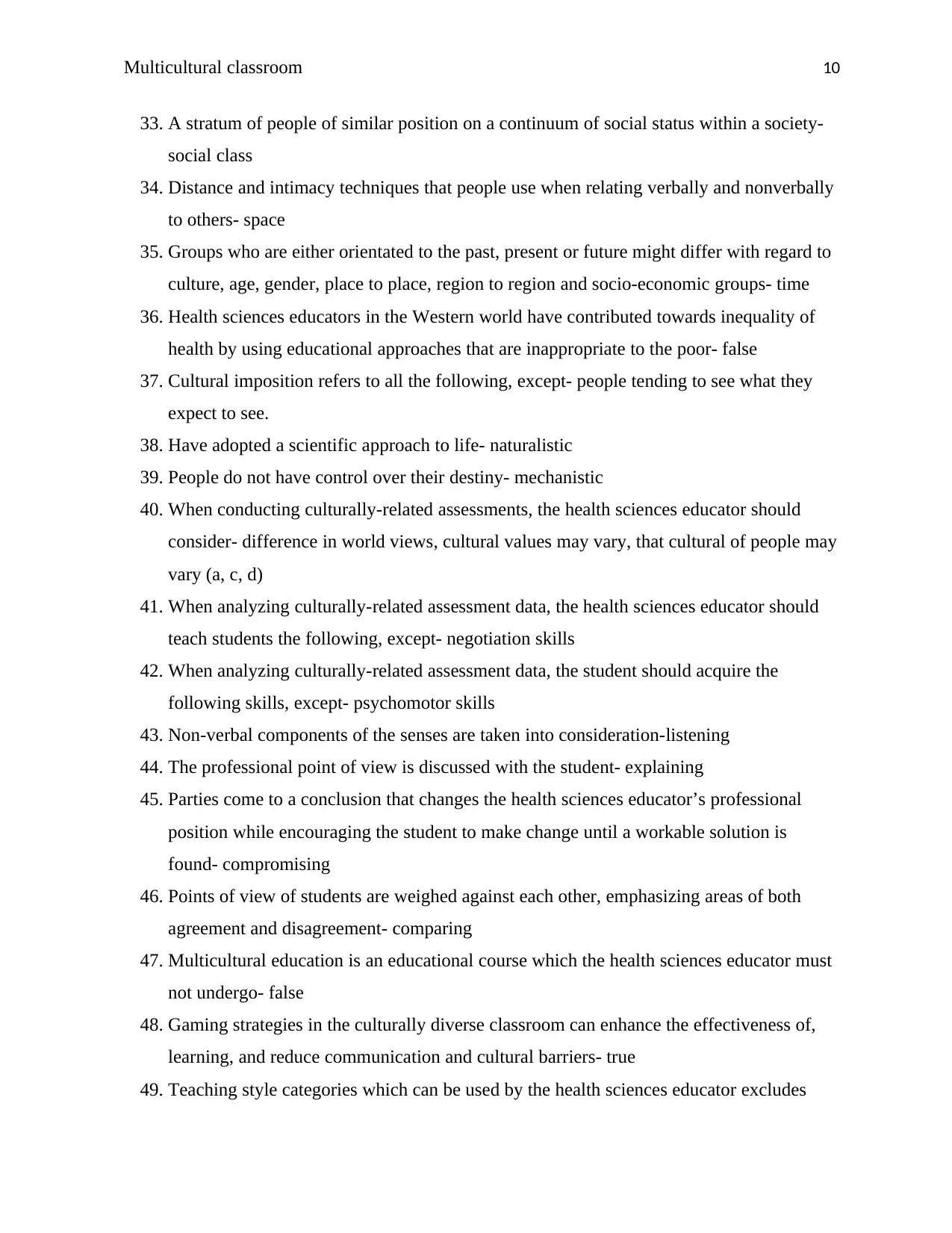
Multicultural classroom 10
33. A stratum of people of similar position on a continuum of social status within a society-
social class
34. Distance and intimacy techniques that people use when relating verbally and nonverbally
to others- space
35. Groups who are either orientated to the past, present or future might differ with regard to
culture, age, gender, place to place, region to region and socio-economic groups- time
36. Health sciences educators in the Western world have contributed towards inequality of
health by using educational approaches that are inappropriate to the poor- false
37. Cultural imposition refers to all the following, except- people tending to see what they
expect to see.
38. Have adopted a scientific approach to life- naturalistic
39. People do not have control over their destiny- mechanistic
40. When conducting culturally-related assessments, the health sciences educator should
consider- difference in world views, cultural values may vary, that cultural of people may
vary (a, c, d)
41. When analyzing culturally-related assessment data, the health sciences educator should
teach students the following, except- negotiation skills
42. When analyzing culturally-related assessment data, the student should acquire the
following skills, except- psychomotor skills
43. Non-verbal components of the senses are taken into consideration-listening
44. The professional point of view is discussed with the student- explaining
45. Parties come to a conclusion that changes the health sciences educator’s professional
position while encouraging the student to make change until a workable solution is
found- compromising
46. Points of view of students are weighed against each other, emphasizing areas of both
agreement and disagreement- comparing
47. Multicultural education is an educational course which the health sciences educator must
not undergo- false
48. Gaming strategies in the culturally diverse classroom can enhance the effectiveness of,
learning, and reduce communication and cultural barriers- true
49. Teaching style categories which can be used by the health sciences educator excludes
33. A stratum of people of similar position on a continuum of social status within a society-
social class
34. Distance and intimacy techniques that people use when relating verbally and nonverbally
to others- space
35. Groups who are either orientated to the past, present or future might differ with regard to
culture, age, gender, place to place, region to region and socio-economic groups- time
36. Health sciences educators in the Western world have contributed towards inequality of
health by using educational approaches that are inappropriate to the poor- false
37. Cultural imposition refers to all the following, except- people tending to see what they
expect to see.
38. Have adopted a scientific approach to life- naturalistic
39. People do not have control over their destiny- mechanistic
40. When conducting culturally-related assessments, the health sciences educator should
consider- difference in world views, cultural values may vary, that cultural of people may
vary (a, c, d)
41. When analyzing culturally-related assessment data, the health sciences educator should
teach students the following, except- negotiation skills
42. When analyzing culturally-related assessment data, the student should acquire the
following skills, except- psychomotor skills
43. Non-verbal components of the senses are taken into consideration-listening
44. The professional point of view is discussed with the student- explaining
45. Parties come to a conclusion that changes the health sciences educator’s professional
position while encouraging the student to make change until a workable solution is
found- compromising
46. Points of view of students are weighed against each other, emphasizing areas of both
agreement and disagreement- comparing
47. Multicultural education is an educational course which the health sciences educator must
not undergo- false
48. Gaming strategies in the culturally diverse classroom can enhance the effectiveness of,
learning, and reduce communication and cultural barriers- true
49. Teaching style categories which can be used by the health sciences educator excludes
Secure Best Marks with AI Grader
Need help grading? Try our AI Grader for instant feedback on your assignments.
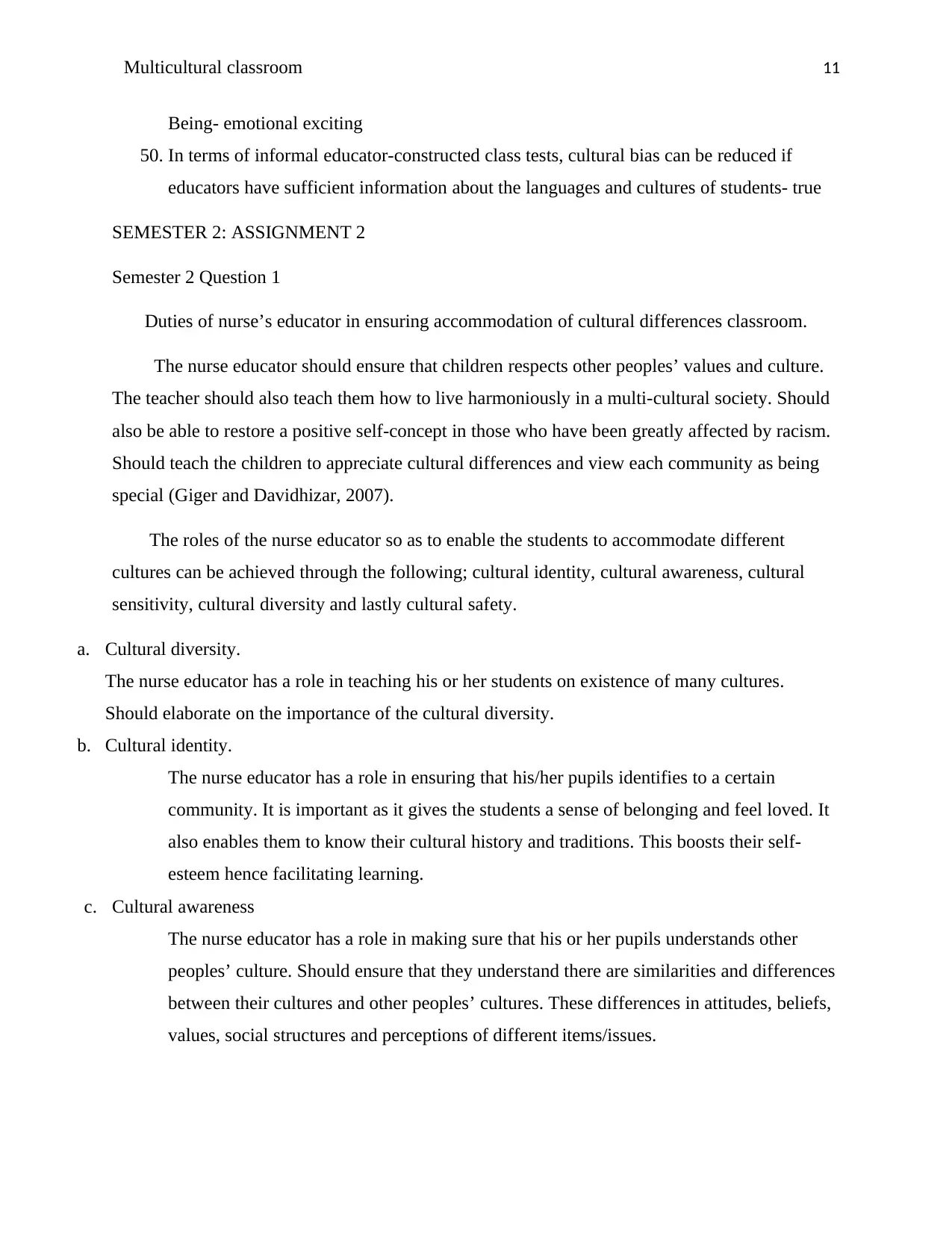
Multicultural classroom 11
Being- emotional exciting
50. In terms of informal educator-constructed class tests, cultural bias can be reduced if
educators have sufficient information about the languages and cultures of students- true
SEMESTER 2: ASSIGNMENT 2
Semester 2 Question 1
Duties of nurse’s educator in ensuring accommodation of cultural differences classroom.
The nurse educator should ensure that children respects other peoples’ values and culture.
The teacher should also teach them how to live harmoniously in a multi-cultural society. Should
also be able to restore a positive self-concept in those who have been greatly affected by racism.
Should teach the children to appreciate cultural differences and view each community as being
special (Giger and Davidhizar, 2007).
The roles of the nurse educator so as to enable the students to accommodate different
cultures can be achieved through the following; cultural identity, cultural awareness, cultural
sensitivity, cultural diversity and lastly cultural safety.
a. Cultural diversity.
The nurse educator has a role in teaching his or her students on existence of many cultures.
Should elaborate on the importance of the cultural diversity.
b. Cultural identity.
The nurse educator has a role in ensuring that his/her pupils identifies to a certain
community. It is important as it gives the students a sense of belonging and feel loved. It
also enables them to know their cultural history and traditions. This boosts their self-
esteem hence facilitating learning.
c. Cultural awareness
The nurse educator has a role in making sure that his or her pupils understands other
peoples’ culture. Should ensure that they understand there are similarities and differences
between their cultures and other peoples’ cultures. These differences in attitudes, beliefs,
values, social structures and perceptions of different items/issues.
Being- emotional exciting
50. In terms of informal educator-constructed class tests, cultural bias can be reduced if
educators have sufficient information about the languages and cultures of students- true
SEMESTER 2: ASSIGNMENT 2
Semester 2 Question 1
Duties of nurse’s educator in ensuring accommodation of cultural differences classroom.
The nurse educator should ensure that children respects other peoples’ values and culture.
The teacher should also teach them how to live harmoniously in a multi-cultural society. Should
also be able to restore a positive self-concept in those who have been greatly affected by racism.
Should teach the children to appreciate cultural differences and view each community as being
special (Giger and Davidhizar, 2007).
The roles of the nurse educator so as to enable the students to accommodate different
cultures can be achieved through the following; cultural identity, cultural awareness, cultural
sensitivity, cultural diversity and lastly cultural safety.
a. Cultural diversity.
The nurse educator has a role in teaching his or her students on existence of many cultures.
Should elaborate on the importance of the cultural diversity.
b. Cultural identity.
The nurse educator has a role in ensuring that his/her pupils identifies to a certain
community. It is important as it gives the students a sense of belonging and feel loved. It
also enables them to know their cultural history and traditions. This boosts their self-
esteem hence facilitating learning.
c. Cultural awareness
The nurse educator has a role in making sure that his or her pupils understands other
peoples’ culture. Should ensure that they understand there are similarities and differences
between their cultures and other peoples’ cultures. These differences in attitudes, beliefs,
values, social structures and perceptions of different items/issues.
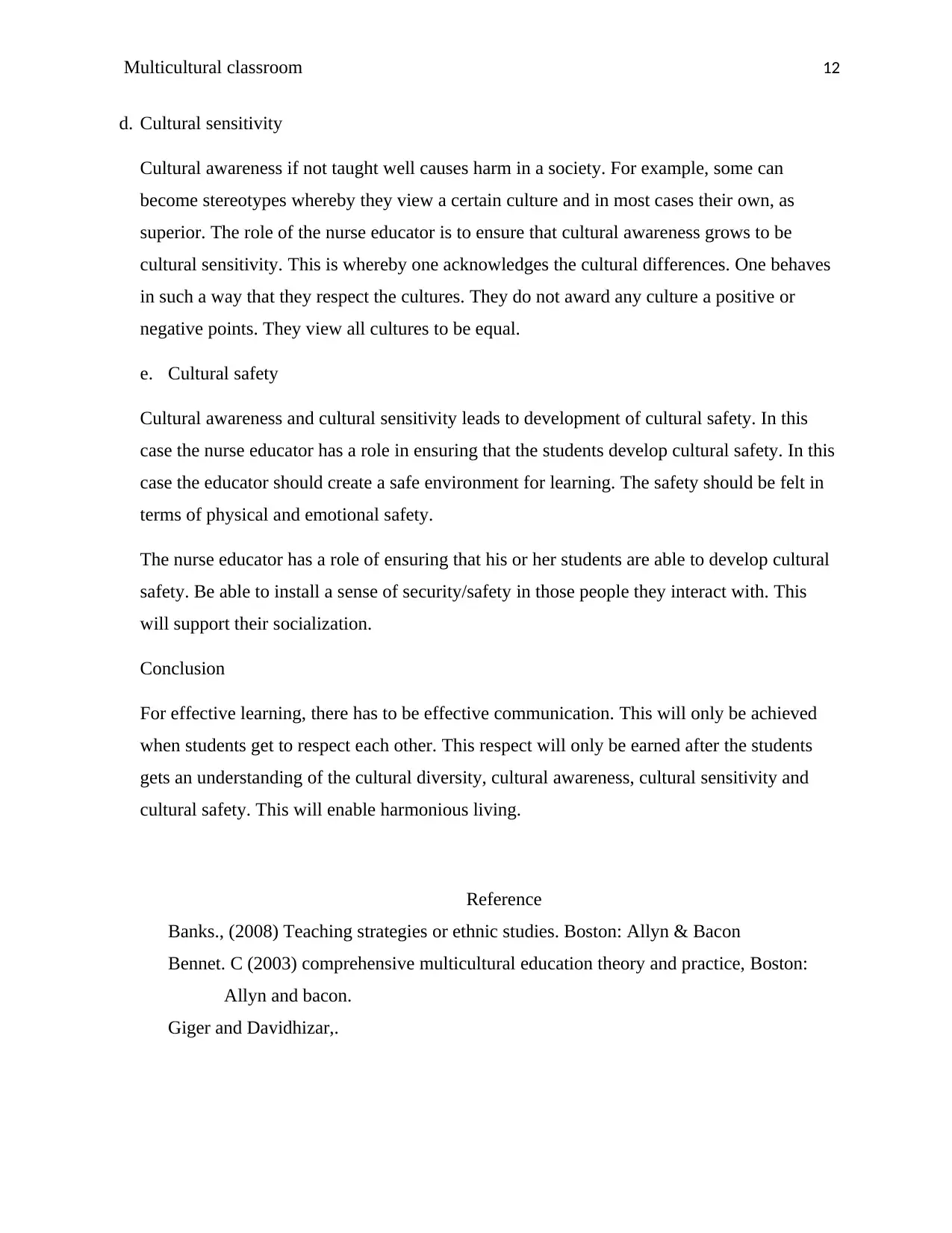
Multicultural classroom 12
d. Cultural sensitivity
Cultural awareness if not taught well causes harm in a society. For example, some can
become stereotypes whereby they view a certain culture and in most cases their own, as
superior. The role of the nurse educator is to ensure that cultural awareness grows to be
cultural sensitivity. This is whereby one acknowledges the cultural differences. One behaves
in such a way that they respect the cultures. They do not award any culture a positive or
negative points. They view all cultures to be equal.
e. Cultural safety
Cultural awareness and cultural sensitivity leads to development of cultural safety. In this
case the nurse educator has a role in ensuring that the students develop cultural safety. In this
case the educator should create a safe environment for learning. The safety should be felt in
terms of physical and emotional safety.
The nurse educator has a role of ensuring that his or her students are able to develop cultural
safety. Be able to install a sense of security/safety in those people they interact with. This
will support their socialization.
Conclusion
For effective learning, there has to be effective communication. This will only be achieved
when students get to respect each other. This respect will only be earned after the students
gets an understanding of the cultural diversity, cultural awareness, cultural sensitivity and
cultural safety. This will enable harmonious living.
Reference
Banks., (2008) Teaching strategies or ethnic studies. Boston: Allyn & Bacon
Bennet. C (2003) comprehensive multicultural education theory and practice, Boston:
Allyn and bacon.
Giger and Davidhizar,.
d. Cultural sensitivity
Cultural awareness if not taught well causes harm in a society. For example, some can
become stereotypes whereby they view a certain culture and in most cases their own, as
superior. The role of the nurse educator is to ensure that cultural awareness grows to be
cultural sensitivity. This is whereby one acknowledges the cultural differences. One behaves
in such a way that they respect the cultures. They do not award any culture a positive or
negative points. They view all cultures to be equal.
e. Cultural safety
Cultural awareness and cultural sensitivity leads to development of cultural safety. In this
case the nurse educator has a role in ensuring that the students develop cultural safety. In this
case the educator should create a safe environment for learning. The safety should be felt in
terms of physical and emotional safety.
The nurse educator has a role of ensuring that his or her students are able to develop cultural
safety. Be able to install a sense of security/safety in those people they interact with. This
will support their socialization.
Conclusion
For effective learning, there has to be effective communication. This will only be achieved
when students get to respect each other. This respect will only be earned after the students
gets an understanding of the cultural diversity, cultural awareness, cultural sensitivity and
cultural safety. This will enable harmonious living.
Reference
Banks., (2008) Teaching strategies or ethnic studies. Boston: Allyn & Bacon
Bennet. C (2003) comprehensive multicultural education theory and practice, Boston:
Allyn and bacon.
Giger and Davidhizar,.
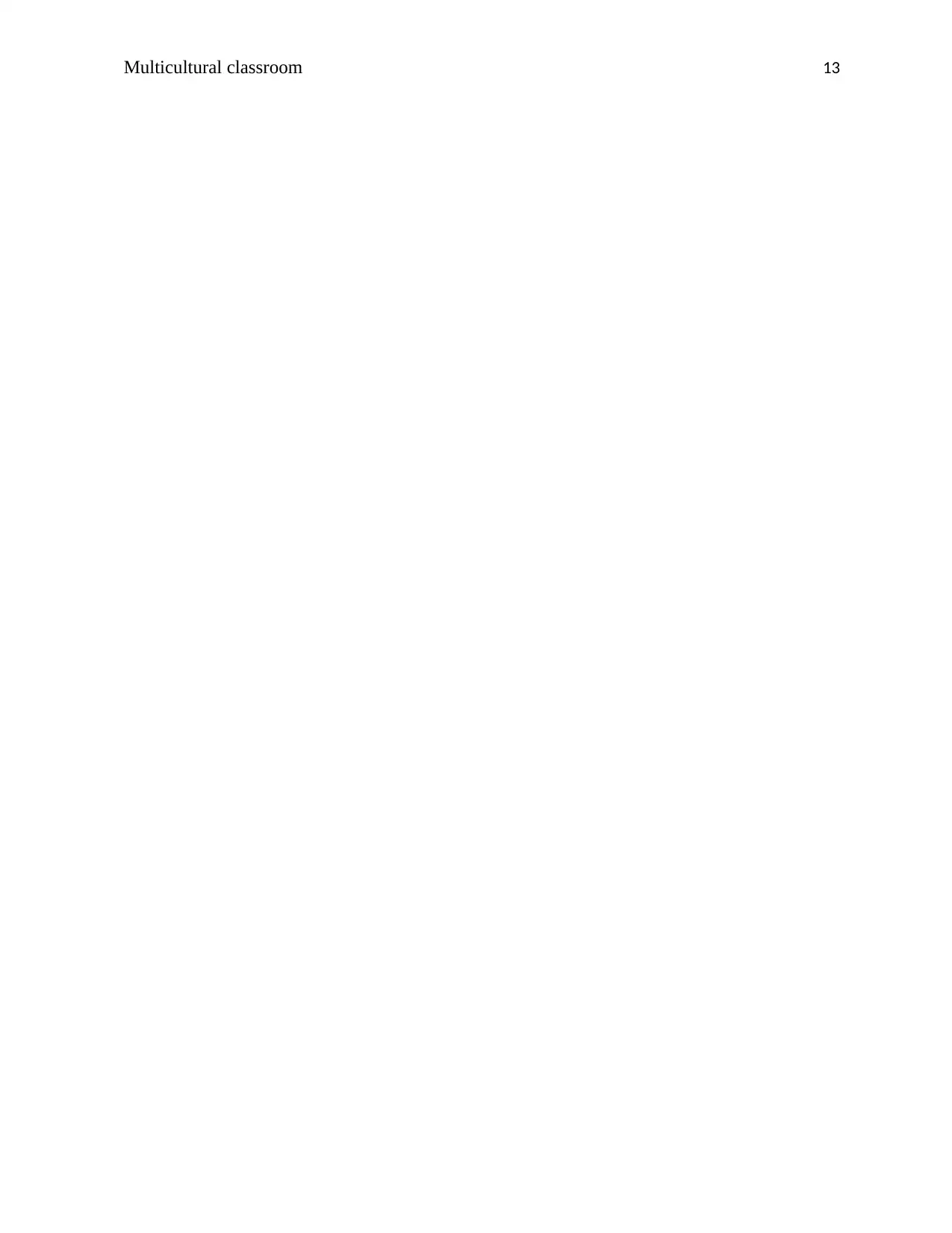
Multicultural classroom 13
1 out of 13
Related Documents
Your All-in-One AI-Powered Toolkit for Academic Success.
+13062052269
info@desklib.com
Available 24*7 on WhatsApp / Email
![[object Object]](/_next/static/media/star-bottom.7253800d.svg)
Unlock your academic potential
© 2024 | Zucol Services PVT LTD | All rights reserved.





